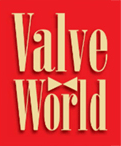Ball check valves
A ball check valve has a ball as the closing part. Typically, the ball is attached to a compression spring, with the ball facing the direction of flow. In other types of ball check valves, there is no spring. A check valve without a spring requires a reverse flow to close. The ball check valve body is conically shaped to guide the ball to the seating position to ensure a positive seal.
The operation of a ball check valve is simple. They are often relatively small and cheap. The balls are made of metal or other materials, in exceptional cases where durability or inert conditions are required.
There is a preference for ball check valves in processes that require no supervision as they require very little maintenance. They are common in spray devices, manual air pumps, refillable dispensing syringes, pumping stations etc.
Double door (dual disc) check valves
In the double door check valve, two disks that open like a door, allow fluid flow. The disks are attached to torsion springs, which keep the disks closed to prevent the flow of fluid.
Double door check valves are low weight, require less space, and are easy to install. They are used with clean fluids in the petrochemical industry, gas liquefaction, HVAC applications, refineries, and other process industries because they are cost-efficient and require low maintenance. Generally, they must be compressed between two flanges.
The lift check valve has a similar design to a globe valve. This check valve uses gravity or a higher pressure at the valve’s outlet to return the valve to the seat position and prevent reverse flow. Some types of lift check valves use a spring-loaded disk.
Lift check valves can be installed horizontally, vertically, or at an angle. The flow enters the check valve from below the seat and lifts the disk positioned between two guides. Lift check valves are recommended in processes with high flow velocities such as steam, air, gas, or vapor lines.
Stop check valve
When you combine the functions of a lift check valve and a globe valve, you get the stop check valve. The stop check valve has a handle that can be connected to an actuator and a stem that limits the disk’s movement. The stem is not connected to the disk. The actuator handle rotates to either prevent the flow of fluid through the valve or limit the flow by constraining the disk travel distance.
The piston check valve has the same characteristics as the lift check valve. Functionally, the main difference is the mechanism for closing the valve – a spring-loaded piston in a cylinder. The cylinder guides the movement of the piston up and down during operation. Applications are to the lift check valve
Swing check valve
A swing check valve consists of a disk that swings on a hinged pivot to allow flow in one direction and swings unto a seat to prevent flow in the other direction. The weight of the disk determines the shut-off characteristics of the valve.
The swing check valve mechanism is commonly used in the flapper valve installed in flush-toilets. It is used in sanitary drainage systems as a backwater valve to prevent flooding by sewage water when there is heavy rainfall.
A wafer check valve is quite similar to a swing check valve. It is simple in design and can be used in tight spaces. The main difference is that they are constrained by flanges that hold them in place. It means that the disk cannot be fully opened, compared to a swing valve with a valve body that allows full opening. The wafer check valve is popularly used when flow is not an issue, or if there is limited space for valve installation.
A diaphragm check valve has an elastic membrane as the sealing mechanism, in a normally closed position. When the pressure upstream of the valve is higher than downstream, the check valve opens and allows fluid flow. Otherwise, the check valve remains closed. They are typically used in low-pressure systems with plastic piping.


